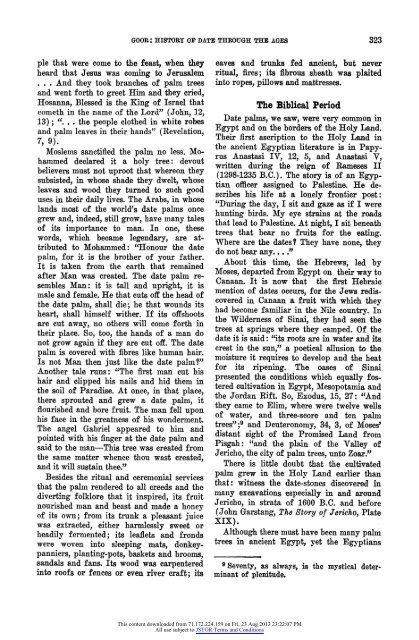The History of the Date through the Ages in the Holy Land
The History of the Date through the Ages in the Holy Land
The History of the Date through the Ages in the Holy Land
Create successful ePaper yourself
Turn your PDF publications into a flip-book with our unique Google optimized e-Paper software.
GOOR: HISTORY OF DATE THROUGH THE AGES 323<br />
ple that were come to <strong>the</strong> feast, when <strong>the</strong>y<br />
heard that Jesus was com<strong>in</strong>g to Jerusalem<br />
. . . And <strong>the</strong>y took branches <strong>of</strong> palm trees<br />
and went forth to greet Him and <strong>the</strong>y cried,<br />
Hosanna, Blessed is <strong>the</strong> K<strong>in</strong>g <strong>of</strong> Israel that<br />
cometh <strong>in</strong> <strong>the</strong> name <strong>of</strong> <strong>the</strong> Lord" (John, 12,<br />
13); ". . . <strong>the</strong> people clo<strong>the</strong>d <strong>in</strong> white robes<br />
and palm leaves <strong>in</strong> <strong>the</strong>ir hands" (Revelation,<br />
7, 9).<br />
Moslems sanctified <strong>the</strong> palm no less. Mohammed<br />
declared it a holy tree: devout<br />
believers must not uproot that whereon <strong>the</strong>y<br />
subsisted, <strong>in</strong> whose shade <strong>the</strong>y dwelt, whose<br />
leaves and wood <strong>the</strong>y turned to such good<br />
uses <strong>in</strong> <strong>the</strong>ir daily lives. <strong>The</strong> Arabs, <strong>in</strong> whose<br />
lands most <strong>of</strong> <strong>the</strong> world's date palms once<br />
grew and, <strong>in</strong>deed, still grow, have many tales<br />
<strong>of</strong> its importance to man. In one, <strong>the</strong>se<br />
words, which became legendary, are attributed<br />
to Mohammed: "Honour <strong>the</strong> date<br />
palm, for it is <strong>the</strong> bro<strong>the</strong>r <strong>of</strong> your fa<strong>the</strong>r.<br />
It is taken from <strong>the</strong> earth that rema<strong>in</strong>ed<br />
after Man was created. <strong>The</strong> date palm resembles<br />
Man: it is tall and upright, it is<br />
male and female. He that cuts <strong>of</strong>f <strong>the</strong> head <strong>of</strong><br />
<strong>the</strong> date palm, shall die; he that wounds its<br />
heart, shall himself wi<strong>the</strong>r. If its <strong>of</strong>fshoots<br />
are cut away, no o<strong>the</strong>rs will come forth <strong>in</strong><br />
<strong>the</strong>ir place. So, too, <strong>the</strong> hands <strong>of</strong> a man do<br />
not grow aga<strong>in</strong> if <strong>the</strong>y are cut <strong>of</strong>f. <strong>The</strong> date<br />
palm is covered with fibres like human hair.<br />
Is not Man <strong>the</strong>n just like <strong>the</strong> date palm?"<br />
Ano<strong>the</strong>r tale runs: "<strong>The</strong> first man cut his<br />
hair and clipped his nails and hid <strong>the</strong>m <strong>in</strong><br />
<strong>the</strong> soil <strong>of</strong> Paradise. At once, <strong>in</strong> that place,<br />
<strong>the</strong>re sprouted and grew a date palm, it<br />
flourished and bore fruit. <strong>The</strong> man fell upon<br />
his face <strong>in</strong> <strong>the</strong> greatness <strong>of</strong> his wonderment.<br />
<strong>The</strong> angel Gabriel appeared to him and<br />
po<strong>in</strong>ted with his f<strong>in</strong>ger at <strong>the</strong> date palm and<br />
said to <strong>the</strong> man-This tree was created from<br />
<strong>the</strong> same matter whence thou wast created,<br />
and it will susta<strong>in</strong> <strong>the</strong>e."<br />
Besides <strong>the</strong> ritual and ceremonial services<br />
that <strong>the</strong> palm rendered to all creeds and <strong>the</strong><br />
divert<strong>in</strong>g folklore that it <strong>in</strong>spired, its fruit<br />
nourished man and beast and made a honey<br />
<strong>of</strong> its own; from its trunk a pleasant juice<br />
was extracted, ei<strong>the</strong>r harmlessly sweet or<br />
headily fermented; its leaflets and fronds<br />
were woven <strong>in</strong>to sleep<strong>in</strong>g mats, donkeypanniers,<br />
plant<strong>in</strong>g-pots, baskets and brooms,<br />
sandals and fans. Its wood was carpentered<br />
<strong>in</strong>to ro<strong>of</strong>s or fences or even river craft; its<br />
eaves and trunks fed ancient, but never<br />
ritual, fires; its fibrous sheath was plaited<br />
<strong>in</strong>to ropes, pillows and mattresses.<br />
<strong>The</strong> Biblical Period<br />
<strong>Date</strong> palms, we saw, were very common <strong>in</strong><br />
Egypt and on <strong>the</strong> borders <strong>of</strong> <strong>the</strong> <strong>Holy</strong> <strong>Land</strong>.<br />
<strong>The</strong>ir first ascription to <strong>the</strong> <strong>Holy</strong> <strong>Land</strong> <strong>in</strong><br />
<strong>the</strong> ancient Egyptian literature is <strong>in</strong> Papyrus<br />
Anastasi IV, 12, 5, and Anastasi V,<br />
written dur<strong>in</strong>g <strong>the</strong> reign <strong>of</strong> Rameses II<br />
(1298-1235 B.C.). <strong>The</strong> story is <strong>of</strong> an Egyptian<br />
<strong>of</strong>ficer assigned to Palest<strong>in</strong>e. He describes<br />
his life at a lonely frontier post:<br />
"Dur<strong>in</strong>g <strong>the</strong> day, I sit and gaze as if I were<br />
hunt<strong>in</strong>g birds. My eye stra<strong>in</strong>s at <strong>the</strong> roads<br />
that lead to Palest<strong>in</strong>e. At night, I sit beneath<br />
trees that bear no fruits for <strong>the</strong> eat<strong>in</strong>g.<br />
Where are <strong>the</strong> dates? <strong>The</strong>y have none, <strong>the</strong>y<br />
do not bear any...."<br />
About this time, <strong>the</strong> Hebrews, led by<br />
Moses, departed from Egypt on <strong>the</strong>ir way to<br />
Canaan. It is now that <strong>the</strong> first Hebraic<br />
mention <strong>of</strong> dates occurs, for <strong>the</strong> Jews rediscovered<br />
<strong>in</strong> Canaan a fruit with which <strong>the</strong>y<br />
had become familiar <strong>in</strong> <strong>the</strong> Nile country. In<br />
<strong>the</strong> Wilderness <strong>of</strong> S<strong>in</strong>ai, <strong>the</strong>y had seen <strong>the</strong><br />
trees at spr<strong>in</strong>gs where <strong>the</strong>y camped. Of <strong>the</strong><br />
date it is said: "its roots are <strong>in</strong> water and its<br />
crest <strong>in</strong> <strong>the</strong> sun," a poetical allusion to <strong>the</strong><br />
moisture it requires to develop and <strong>the</strong> heat<br />
for its ripen<strong>in</strong>g. <strong>The</strong> oases <strong>of</strong> S<strong>in</strong>ai<br />
presented <strong>the</strong> conditions which equally fostered<br />
cultivation <strong>in</strong> Egypt, Mesopotamia and<br />
<strong>the</strong> Jordan Rift. So, Exodus, 15, 27: "And<br />
<strong>the</strong>y came to Elim, where were twelve wells<br />
<strong>of</strong> water, and three-score and ten palm<br />
trees";9 and Deuteronomy, 34, 3, <strong>of</strong> Moses'<br />
distant sight <strong>of</strong> <strong>the</strong> Promised <strong>Land</strong> from<br />
Pisgah: "and <strong>the</strong> pla<strong>in</strong> <strong>of</strong> <strong>the</strong> Valley <strong>of</strong><br />
Jericho, <strong>the</strong> city <strong>of</strong> palm trees, unto Zoar."<br />
<strong>The</strong>re is little doubt that <strong>the</strong> cultivated<br />
palm grew <strong>in</strong> <strong>the</strong> <strong>Holy</strong> <strong>Land</strong> earlier than<br />
that: witness <strong>the</strong> date-stones discovered <strong>in</strong><br />
many excavations especially <strong>in</strong> and around<br />
Jericho, <strong>in</strong> strata <strong>of</strong> 1600 B.C. and before<br />
(John Garstang, <strong>The</strong> Story <strong>of</strong> Jericho, Plate<br />
XIX).<br />
Although <strong>the</strong>re must have been many palm<br />
trees <strong>in</strong> ancient Egypt, yet <strong>the</strong> Egyptians<br />
9 Seventy, as always, is <strong>the</strong> mystical determ<strong>in</strong>ant<br />
<strong>of</strong> plenitude,<br />
This content downloaded from 71.172.224.159 on Fri, 23 Aug 2013 23:22:07 PM<br />
All use subject to JSTOR Terms and Conditions
















